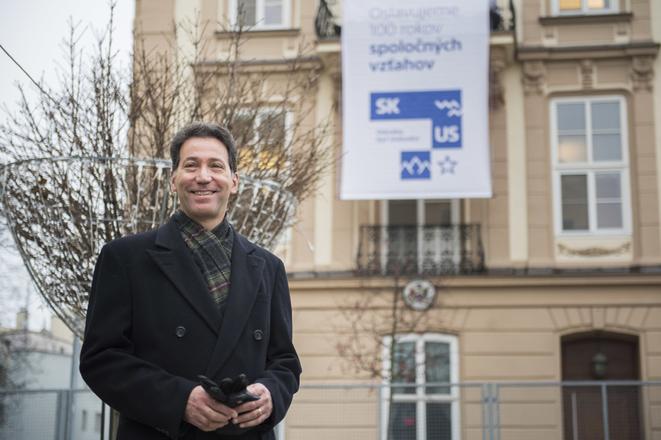January 8th is a special day in the history of US-Slovak relations. On this very day in 1918, US President Woodrow Wilson first announced his 14 Points, a statement for peace, in a speech to the US Congress.
“In that speech, he called for, among other things, freedom and self-determination for the various nations living within the Austro-Hungarian Empire,” US Ambassador to Slovakia, Adam Sterling, told the press.
On the occasion of the anniversary, the US Embassy unveiled a banner situated on its building on Hviezdoslavovo Námestie, beginning the celebrations of 100 years of US-Slovak relations.
Its main motto is: “The United States and Slovakia: The Courage to Be Free”.
Events to remember
Slovakia remembers two important anniversaries this year: 100 years since the first Czechoslovak Republic was established and 25 years since becoming an independent state.
The history of the mutual relationship between the United States and Slovakia started much earlier than 1918, though. It goes back to the 19th century when the migration of hundreds of thousands of Slovaks to America started.
Besides President Wilson's 14 Points, other important milestones include the 1918 Pittsburgh Agreement, as well as US aid to help Slovakia build its civil society and democratic institutions throughout the 1990s and early 2000s including support for its entry into NATO in 2004.
America has assisted Slovakia on its path to stability, security, and prosperity, the US ambassador said.
Road show and bicycle tour
The embassy will trace the history of this mutual relationship with various events.
“During the year, we’ll tell the stories of Slovaks and Americans who have done extraordinary things for our countries,” Sterling added, referring to people like Milan Rastislav Štefánik, Woodrow Wilson, Edward Baranski and Michal Strank (Slovak-Americans who fought to liberate Europe and the Pacific from the Axis powers during World War II).
The embassy will also feature contemporary Slovaks and Americans “who continue to shape the ties between our countries today”, Sterling said.
Other activities include a road show to 32 cities, towns and villages across Slovakia, a Woodrow Wilson Award ceremony recognising people for their significant contributions to US-Slovak relations, a bicycle tour, performances by the U.S. Air Force in European musical groups around Slovakia, a video competition as well as films screenings and a book launch.
A part of the activities will also be branding.
“When we were working to develop this branding, we focused on the qualities that unite our people – a love of freedom and a shared history of struggle for self-determination and sovereignty,” Sterling said. “Our branding reflects these qualities and neatly sums up the values that our countries share.”



 US Ambassador to Slovakia, Adam Sterling (source: TASR)
US Ambassador to Slovakia, Adam Sterling (source: TASR)